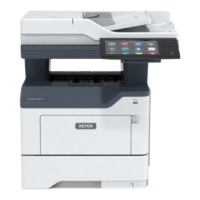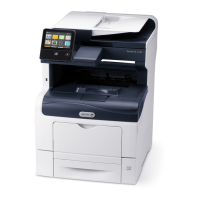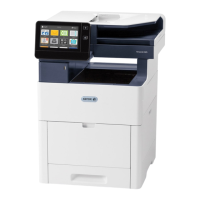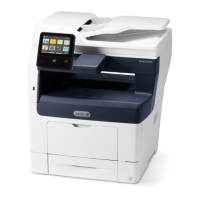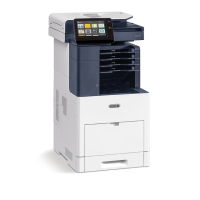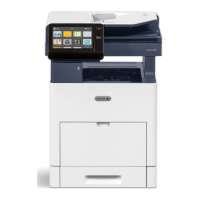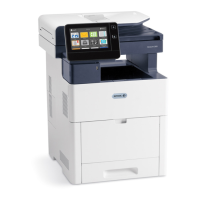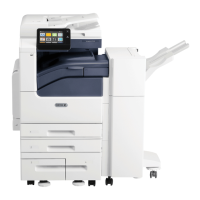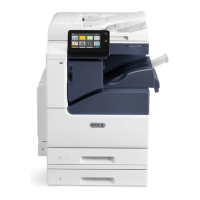Do you have a question about the Xerox VersaLink and is the answer not in the manual?
Configure minimum and maximum length for user and administrator authentication passwords.
Change administrator password upon installation and periodically for enhanced security.
Establish local, network (LDAP/Kerberos), or smart card authentication for device access.
Configure device authorization by adding user roles and assigning permissions.
Enable personalization using LDAP user mappings for customized user experiences.
Enable disk overwrite for VersaLink Multifunction Printers with Hard Disk Drives.
Install and select digital certificates for secure communication and SSL/TLS.
Configure TLS for secure communication, disabling SSLv3.0 and TLS 1.0.
Enable FIPS 140-2 mode for encryption of transmitted and stored data.
Disk encryption is automatically enabled on VersaLink devices.
Enable and configure IP address filtering to control network access.
Enable, download, and review audit logs for security monitoring and event tracking.
Enable and configure IPSec to secure printing jobs and other network traffic.
Configure session inactivity timers to automatically terminate inactive sessions.
Configure secure print jobs by disabling other print types except 'Secure'.
Enable and configure 802.1x device authentication for network access control.
Enable or disable USB ports to control the use of external storage devices.
Enable and configure S/MIME for secure scan-to-email functionality.
Enable and configure IPv4 and IPv6 settings for network connectivity.
Ensure correct date, time, and time zone are set for accurate logging and operations.
Configure general settings, policies, and secure receive for Embedded Fax.
Configure domain filtering and SMTP authentication for secure Scan to Email.
Disable FTP and configure secure login methods for Scan to My Folder.
Configure SNTP server for synchronizing the device's internal system time.
Enable SNMPv3 after SSL/HTTPS is enabled; change default community strings.
Connect to wireless networks using WPA2; disable WEP for secure wireless access.
Regularly change Smart Card/CAC and Secure Print passcodes with minimum lengths.
Ensure local usernames match domain names for consistent user identification.
Manage Image Overwrite (IIO/ODIO) for secure data deletion before decommissioning.
Review audit logs for extraneous entries and protect exported log records.
Avoid blocking port 80 traffic; drop external user traffic to open ports.
Ensure user permission role names do not contain single or double quotes.
Provide users with training on secure device usage before assigning access.
Advise users to switch browsers if experiencing login issues via the Web UI.
Install in standard environments and inform personnel about security and job pickup.
Caution that administrators can disable secure functions; review configurations periodically.
Administrators should avoid unknown emails/attachments unless scanned for viruses.
Use dedicated browsers, log off promptly, and avoid saving credentials for Web UI access.
Configure minimum and maximum length for user and administrator authentication passwords.
Change administrator password upon installation and periodically for enhanced security.
Establish local, network (LDAP/Kerberos), or smart card authentication for device access.
Configure device authorization by adding user roles and assigning permissions.
Enable personalization using LDAP user mappings for customized user experiences.
Enable disk overwrite for VersaLink Multifunction Printers with Hard Disk Drives.
Install and select digital certificates for secure communication and SSL/TLS.
Configure TLS for secure communication, disabling SSLv3.0 and TLS 1.0.
Enable FIPS 140-2 mode for encryption of transmitted and stored data.
Disk encryption is automatically enabled on VersaLink devices.
Enable and configure IP address filtering to control network access.
Enable, download, and review audit logs for security monitoring and event tracking.
Enable and configure IPSec to secure printing jobs and other network traffic.
Configure session inactivity timers to automatically terminate inactive sessions.
Configure secure print jobs by disabling other print types except 'Secure'.
Enable and configure 802.1x device authentication for network access control.
Enable or disable USB ports to control the use of external storage devices.
Enable and configure S/MIME for secure scan-to-email functionality.
Enable and configure IPv4 and IPv6 settings for network connectivity.
Ensure correct date, time, and time zone are set for accurate logging and operations.
Configure general settings, policies, and secure receive for Embedded Fax.
Configure domain filtering and SMTP authentication for secure Scan to Email.
Disable FTP and configure secure login methods for Scan to My Folder.
Configure SNTP server for synchronizing the device's internal system time.
Enable SNMPv3 after SSL/HTTPS is enabled; change default community strings.
Connect to wireless networks using WPA2; disable WEP for secure wireless access.
Regularly change Smart Card/CAC and Secure Print passcodes with minimum lengths.
Ensure local usernames match domain names for consistent user identification.
Manage Image Overwrite (IIO/ODIO) for secure data deletion before decommissioning.
Review audit logs for extraneous entries and protect exported log records.
Avoid blocking port 80 traffic; drop external user traffic to open ports.
Ensure user permission role names do not contain single or double quotes.
Provide users with training on secure device usage before assigning access.
Advise users to switch browsers if experiencing login issues via the Web UI.
Install in standard environments and inform personnel about security and job pickup.
Caution that administrators can disable secure functions; review configurations periodically.
Administrators should avoid unknown emails/attachments unless scanned for viruses.
Use dedicated browsers, log off promptly, and avoid saving credentials for Web UI access.
| Print Technology | Laser |
|---|---|
| Print Resolution | Up to 1200 x 2400 dpi |
| Automatic Duplexing | Yes |
| Memory (Standard) | 2 GB |
| Control Panel | 5-inch color touch screen |
| Copy Resolution | Up to 600 x 600 dpi |
| Fax Speed | 33.6 Kbps |
| Functions | Print, Copy, Scan, Fax |
| Paper Size | A4, A5, B5, Legal, Letter |
| Connectivity | USB, Ethernet, Wi-Fi |
| Mobile Printing | Apple AirPrint, Google Cloud Print, Mopria |
